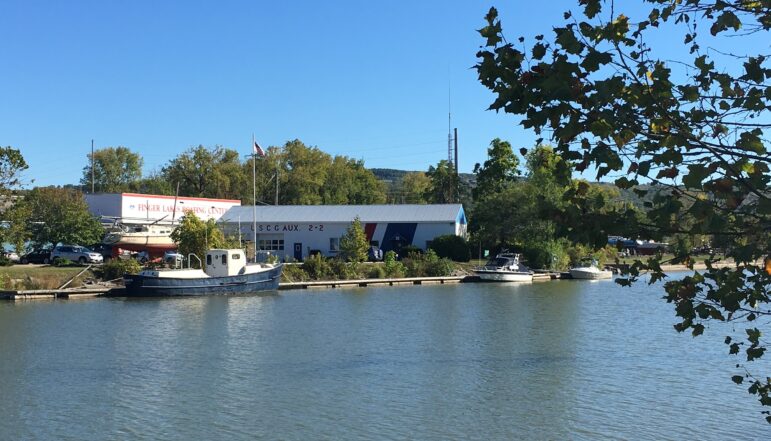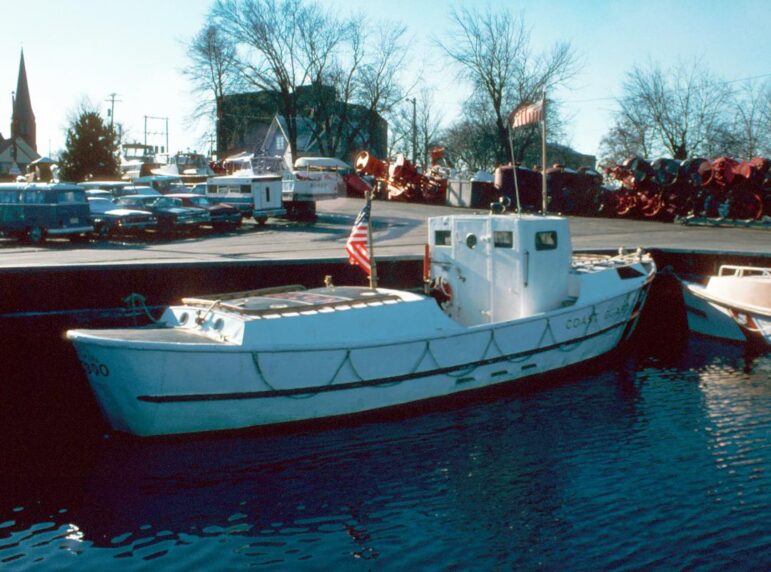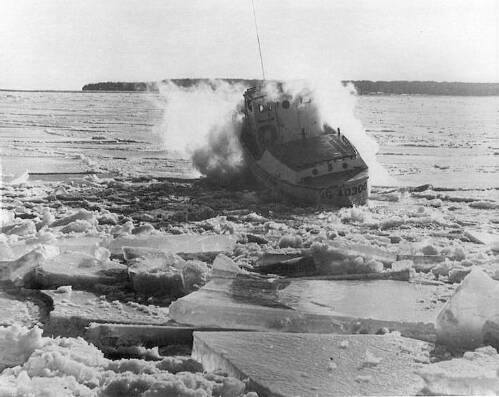By ERIC FREEDMAN
Capital News Service
LANSING – For close to four decades, U.S. Coast Guard motor lifeboat 40300 was on duty in Lake Michigan, stationed primarily at the Plum Island Lifeboat Station at the tip of Wisconsin’s Door Peninsula and later in Escanaba.
In 1983, the federal government transferred the boat to the Eastern Upper Peninsula Transportation Authority at Sault Ste. Marie for use as a utility boat and icebreaker.
Now at age 81 and in private hands, CG 40300 is berthed in New York’s Finger Lakes region as part of the Coast Guard Auxiliary’s Flotilla 2-2 in Cayuga Lake.
The 40-foot-long steel prototype is among the most recent properties added to the National Register of Historic Place, based on its importance in maritime engineering and maritime history.

Courtesy photo
Motor lifeboat CG 40300, docked at Coast Guard Auxiliary Flotilla 2-2 Base in Ithaca, New York, is undergoing restoration.The National Register is the official list of the country’s historic places deemed worthy of preservation. It’s part of a National Park Service program that coordinates and supports private and public attempts to identify and evaluate U.S. history.
CG 40300 was an experiment, the Coast Guard’s first steel motor lifeboat and intended to pioneer the agency’s transition from 36-foot-long wooden craft.
It was built in 1940 “to handle rugged sea and weather conditions with a high degree of stability, great strength of construction, self-righting and self-bailing, and ice-breaking capabilities,” the National Register nomination says. It normally had a crew of four.
The current owner, John Frieman of Owego, New York, said the advent of World War II “killed that project” because steel was in high demand for military needs. He bought CG 40300 from a previous private owner and trucked it from the U.P. to Cayuga Lake in Ithaca, New York in 2017.
“This may be the first steel motor lifeboat in the world,” said the 72-year-old engineer, who has a background in naval architecture and museum conservation. “This is the grandfather of all of them.”
In addition to search-and-rescue activities, CG 40300 carried supplies to lighthouses on Lake Michigan’s Pilot and Plum islands. It wintered at Washington Island, where it broke ice for the local ferry, according to the National Register nomination.
“Sometimes the ice would become too thick for the wooden ferry even after being broken by CG 40300,” it said. “At those times, if there was an urgent need, CG 40300 became the ferry of last resort.”
The National Register documentation includes crew member David Robb’s account of a dangerous mid-1960s operation to help a heavily laden barge buffeted by gale winds gusting 25 to 35 knots.
Robb wrote of feeling “the full fury of Lake Michigan on our starboard side. With the pounding of the bow into the waves, it combined into a dizzy corkscrew motion that resulted in some serious seasickness.”
He told of a “bone-chilling cold” from icy waves washing over the crew, of “three hours of hellish misery. The boat exploded over each crest and flopped down on the other side for a dizzying surf nearly out of control.”
“On top of the crests, we screamed to be heard. In the troughs, we could whisper if it weren’t for the roar of the diesel,” he wrote.

Robb was one of three former crew members Frieman interviewed for his research about CG 40300.
“They all loved the boat because it was such a solid, stable platform. You go out and know nothing is going to hurt this boat,” he said. “That confidence really helps when you’re going out into really bad weather where the risk is really high.”
The Coast Guard removed it from service in 1979 after 33 years at Plum and Washington islands and three years at the Aids to Navigation Station in Escanaba. Then it worked the Sault Ste. Marie Canal for almost another two decades, Frieman said.
The transportation authority worked it in the Sault Ste. Marie Canal until selling it in 2003, he said.
Former authority mechanic Arthur Black of Sault Ste. Marie says it was used when ice prevented ferries from running and described an incident when the wind was pushing it so hard it nearly ended up on Drummond Island.
“That thing rolled and pitched,” said Black, who remembers rebuilding the pilot house.
Although in use almost continually since 1940, the nomination said, “There have been few changes, and the boat remains in very good condition.”
Frieman said: “Easily 90% of the boat is original. Considering she was in quite heavy use for the first 60 years of her existence, that’s doing really well. A lot of that is a credit to the Coast Guard, which built the boat and the guys who kept her up during years of service. They never let the boat get rusty.”
Since buying the boat, he’s done a lot of work “as time and funding allows,” including on the wiring and electric system, batteries and wooden features, as well as building a windshield. Painting is ahead, with the aim of restoring it as it was in the 1960s.

Courtesy photo
CG 40300 works the ice on Lake Michigan around 1970.“The working part of the boat, in terms of going somewhere, is completely functionable. The steel is in good shape all around the boat,” he said.
Frieman is a Coast Guard Auxiliary volunteer staff officer for marine safety and environmental protection and says CG 40300 draws attention from boaters who stop to see the historic craft and talk about marine safety.
He renamed it Acadia in honor of the hospital ship where his parents met and served during World War II.